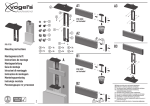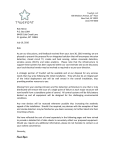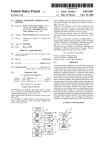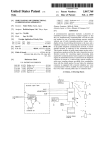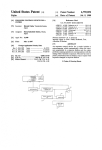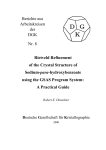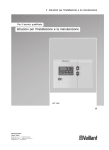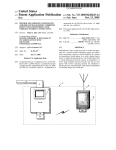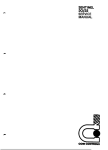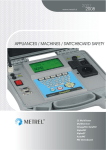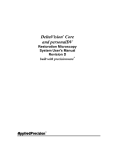Download Ignition timing control system and method for an internal combustion
Transcript
United States Patent [191 Morita [54] IGNITION TIMING CONTROL SYSTEM 3309947 COMBUSTION ENGINE 7/1984 Fed. Rep. of Germany .... .. 123/422 58-217775 12/1983 59-168266 Tatsuo Morita, Yokosuka, Japan Japan .................. .. 123/425 9/1984 Japan ................................. .. 123/422 OTHER PUBLICATIONS “VG-Series Engine Service Manual 1983” Jun. 1983, by Nissan Motor Company, Limited. Primary Examiner-Andrew M. Dolinar Attorney, Agent, or Firm-Schwartz, Jeffery, Schwaab, Mack, Blumenthal & Evans [73] Assignee: Nissan Motor Company, Limited, Yokohama, Japan [21] Appl. No.: 809,733 Dec. 17, 1985 [22] Filed: [30] Foreign Application Priority Data Jan. 31, 1985 [JP] Jan. 31, 1985 [JP] Apr. 21, 1987 FOREIGN PATENT DOCUMENTS AND METHOD FOR AN INTERNAL [75] Inventor: 4,658,789 Patent Number: Date of Patent: [11] [45] [57] Japan ................................ .. 60-18058 Japan ................................ .. 60-18059 [51] [52] Int. Cl.4 .............................. .. F02P 5/145 US. Cl. ........................ .. 123/422; 123/425 [58] Field of Search ............. .. 123/415, 416, 417, 422, ABSTRACT A system and method for controlling the ignition timing of an internal combustion engine, in which a predeter mined transient state which increase the probability of engine knocking is detected, a basic ignition advance angle value determined by an engine operating condi— tion is corrected by a retardation angle value which is 123/423, 425 stored when knocking is suppressed during the prede [56] References Cited U.S. PATENT DOCUMENTS 4,428,343 4,448,163 termined transient state and is returned quickly toward the basic advance angle while ensuring that engine knocking will not recur after the predetermined tran 1/ 1984 Schweikert et a1. .............. .. 123/425 5/1984 Yoshida ..................... .. 123/422 4,508,079 4/ 1985 Komurasaki et a1. . 4,513,716 4/1985 123/422 I’ — _ _ _ _ _ _ — ‘_‘| I I , \. ’——~'——-—-I - . KNOCKING l5“ ‘ DISCRIMINATOR [ 34 i l , I | I SAk SAm ' CORRECTION Vn , Tn TRANSIENT . l : | l I ‘ : regret : DETECTOR l I.‘ ___ Ve 33 xuocxms SENSOR LP‘ 12 ) _____1 "_‘ s 'GN'T'ON GENERATOR -$p IGNITION MEANS I 5A0 : 8 ' ' I 2 24 Tp : 1 | Tr :| Tp I CALCULATOR : ' i ‘ i L_‘:Z_______l 32 ' 2 SA ; _--> SIGNAL l l 5k EQE'ENT DETECTOR UNIT : CALCULATOR : . i- , 1 £3.13?" 1 q I 13 ISAk l -—-— conaec'ron ; s CONTROL ,.44 rI ____ __/___.|l l I 1I l/ | 1 l DETECTOR _..43 I CALCULATOR : ) ' ‘31 - l I ' i 13 Claims, 18 Drawing Figures Haraguchi et al. ............... .. 123/422 42 ‘ sient state is over. ' _ Oz: F AIRFLOW , _ /l0 ‘ N ANGLE E" "4] CRANK MET 15/ ssuson . U. S. Patent Apr. 21, 1987 AOEPZU .523 Sheetl ofll 4,658,789 N Q m_ oziu mowz / NCOHMEWQN U. S. Patent Apr.21, 1987 .whmm, @025QS\ ‘ Sheet3 ofll 4,658,789 U. S. Patent Apr. 21, 1987 Sheet4 of 11 FIG14 (a) 4,658,789 ’ } LRIA'IZSAUKNETAIR FUEL/ INTAKE AIR FIG.4 (b) LEfN AIR-FUEL MIXTURE E RATIO ' l l RICH I _FIG.4 g (c) , KNOCKING INTENSITY FIG’.4 (d) RETARD ANGLE CORRECTION ‘ SAk+ > 1 - I : . _ ‘ . _ :_ I _ REFERENCE ° U. S. Patent Apr. 21, 1987 Sheet 6 of 11 4,658,789 FIG.6(Q) @ P1“ CALCULATE SAo P2 ATP 2 2m sec ? . YES P3\ - c1 = 4 NF = 0 P4 C1 = 0 YES 2 I P N0 ‘ 5N P7 NF = 0 f P9“ c1 1- c1-1 P - YES P“\ v NF =1 02 = 20 / i P12 \ SAk <- SAm P‘3\ CALCULATE SA i P" “ ' OUTPUT Sp G353 - US. Patent Apr. 21, 1987 Sheet7 ofll 4,658,789 FIG.6(b) P15 I P"\ YES NF'= 0 C1 = 0 b P“‘\ (a) SAm <- SAk SAk <F 0 IS KNOCKING PRESENT ? ‘ -»Pz0 CORRECT BY ADVANCE ANGLE 4-' P19\ CORRECT BY RETARD ANGLE "J U. S. Patent Apr. 21, 1987 FIG.8 (c1) 4,658,789 Sheet 9 of 11 @ CALCULATE SAo SP2 NO ‘ YES SP3 \ F=0 Cb SP7 ' SP1” N0 I . (b) ‘ YES SP11 _\ NF : 1 C2 = SP1: . \ 1 SAk ‘— SAm SP13\ CALCULATE sA 1 SP1“ OUTPUT Sp @ . $ U. S. Patent Apr.2l, 1987 Sheet 10 ofll 4,658,789 FIG-7.8 (b) SP6 SPaN SP15 NO YES SP17 NF : 0 C1 = 0 $P=1\ SAm <- SAk ADF = 1 IS KNOCKING PRESENT ? SP16 SP33 \ \ . sP32 , SP34 \ ‘ CORRECT BY $5255? BY ' SLOW CORRECT .BY RETABD ADVANCE ADVANCE ANGLE ANGLE + SP35 S ANGLE ADF = 0 +VJ U. S. Patent Apr. 21, 1987 FIG-7.9 (a) Sheet 11 ofll 4,658,789 I l | INJECTION I AMOUNT , Tp - ' l | I l FIG. 91 l 2o (b) COUNT VALUE C1, C2 Fig.9k (C) , Y H i 5 RETARD ANGLE CORRECTION ABRUPT ADVANCE ANGLE CORRECTION ' ' m ' : I ‘SAk ~+T|ME sAm I I. | WHEN ' 1 l I SAm : l | l | l I 1 | I t11 t12 us | KNOCKING r | IS PRESENT‘ f l ‘(14 Y 1 4,658,789 IGNITION TIMING CONTROL SYSTEM AND FIG. 2 is a block diagram of the major functional element of the ignition timing control system. The con~ METHOD FOR AN INTERNAL COMBUSTION ENGINE trol unit 16 comprises functionally a correction amount calculator 21, a corrector 22, an ignition signal genera tor 23, an ignition timing calculator 24, and a Tp calcu BACKGROUND OF THE INVENTION 1. Field of the Invention The present invention relates generally to an ignition timing control system for a vehicular internal combus tion engine which prevents the occurrence of engine lator 25. The Tp calculator 25 receives signals from the air ?ow meter 10 and crank angle sensor 15 and derives the basic fuel injection amount Tp. The basic fuel injec tion amount Tp in units of milliseconds (since the fuel knocking. injector 4 opens to inject fuel at a ?xed rate for an open 2. Description of the Prior Art It is desirable to prevent occurrence of engine knock ing which is due mainly to accelerated violent burning of uncombusted gas since knocking brings about energy losses (reduction of engine output) and applies shocks to all parts of the engine and furthermore increases fuel ing duration determined by a pulse duration) is derived from the following equation (1) and the results of this calculation are outputted to the ignition timing calcula tor 24: Tp=KxQa/N consumption. A conventional system for controlling ignition timing (l) where K is a constant so as to suppress knocking is exempli?ed by “VG-series The ignition timing calculator 24 receives the signal Engine Service Manual 1983” published by Nissan from the crank angle sensor 15. The ignition timing calculator 24 looks up a basic advance angle value SAo Motor Co., Ltd. on June 1983. FIGS. 1 through 4 show the construction and action from a three-dimensional table map using known table of the conventional ignition timing control system dis closed in the above-identi?ed Japanese document. In FIG. 1, 1 denotes an engine. Intake air is supplied to each engine cylinder via an intake air pipe 3 from an air cleaner 2 while fuel is supplied thereto via a fuel injector 4 according to an injection signal Si. Each cylinder is provided with an ignition plug 5 which re ceives a high-voltage pulse Pi from an ignition coil 7 via a distributor 6 at every ignition timing. The ignition coil 7, the distributor 6, and a plurality of ignition plugs 6 constitute ignition means 8 for igniting and burning the 2 trols the fuel injection amount injected by the fuel injec tor 4, the detailed description thereof is omitted). look-up techniques and outputs the basic advance angle SAo to the corrector 22. Since the basic advance angle value SAo corresponds to an optimum ignition timing according to engine operating conditions, it is repre sented by a crank angle value before top dead center in 30 the compression stroke of a speci?c engine cylinder. The corrector 22 furthermore receives a retard angle correction value SAk from the correction amount cal culator 21. The correction amount calculator 21 calcu lates the retard angle correction value SAk (SAk E0) air-fuel mixture supplied to the engine. The ignition to correct the basic advance angle value SAo toward means 8 generates and discharges the high-voltage pulse Pi in accordance with an ignition signal Sp. In addition, the air-fuel mixture within each engine cylinder is ig nited and exploded in response to discharge of the pulse the retardation side depending on the presence or ab sence of knocking. The initial value of the retard angle correction value SAk is set to 0° and when the knocking discrimination signal Sn is at its high (“H”) level, the Pi and the resulting exhaust gases are exhausted to at 40 value SAk is calculated from the following equation (2) mosphere via an exhaust pipe 9. In addition, the rate of flow Qa of intake air is de for each ignition timing: tected by means of an air ?ow meter 10 and controlled by means of a throttle valve 11 installed within the SAk=SAk'-ASAr, (2) intake air pipe 3. Vibrations Ve in the engine body 1 are detected by a knock sensor 12. An output signal from where SAk’ denotes the retard angle correction amount from the previous ignition timing, SAk a retard the knock sensor 12 is inputted to the knock vibration angle correction amount for the present ignition timing, and ASAr a correction value toward the retardation detector 13. The knock vibration detector 13 comprises side per ignition cycle. a BPF (Band Pass Filter) which enables the passage of only a frequency range corresponding to vibrations due 50 On the other hand, when the signal Sn is at a low to knocking and an integrator which generates a volt (“L”) level (no knocking), the value SAk is updated in age Vn (Vn=0 through 5 V) proportional to the inten sity or amplitude of knocking vibrations generated per the following equation (3): combustion stroke and outputs this voltage to a knock discriminator 14. The knock discriminator 14 compares 55 SAk=SAk’+ASAa, (3) the output voltage Vn of the knock vibration detector where ASAa denotes a correction value toward the 13 to a determinating reference value Vo. If Vn>Vo, the knock discriminator 14 outputs a knock determina advance side per ignition cycle. The upper limit of SAk when updating toward the advance side is zerodegrees (0°) and will never be a positive value exceeding zero tion signal Sn having a high logic level “H”. If VnéVo, the knock determination signal Sn turns to the lower 60 degrees. The corrector 22 corrects the basic advance level “L”. In addition, the engine revolutional speed N angle value SAo with the retardation angle correction value SAk and calculates a ?nal advance angle value of the engine 1 is monitored by a crank angle sensor 15 SA expressed in the following equation (4): built into the distributor 6. The electrical signals from the air flow meter 10, the knock discriminator 14, and SA=SAo+SAk (4) the crank angle sensor 15 are inputted to a control unit 65 16. The control unit 16 carries out the ignition timing control on the basis of the information from the sensors described above (although the control unit 16 also con The ignition signal generator 23 outputs the ignition signal Sp to the ignition means 8 at a timing correspond 3 4,658,789 4 ing to the ?nal advance angle SA. The high-voltage pulse Pi is generated at the same timing to ignite the performance is degraded at the initial stage of accelera air-fuel mixture. In addition, since the process of returning ignition timing toward the advance side upon completion of the _ Hence, if knocking is detected, the ignition timing is tion. repeatedly retarded in small increments to suppress knocking and thereafter, once the knocking stops, the ignition timing is again slowly advanced to hold the knock induction time interval Tn is carried out only with small increments ASAa, a prolonged reduction of optimum combustion state. In this case, the correction gine 1 cannot be prevented. Therefore, the correction of the ignition advance angle needs to be carried out with an improvement in output performance in mind. value ASAr is set approximately to 1° and the value of ASAa is approximately set as follows: ASAa=A SAr><(l/l0 to 1/15). The reason for this difference in value is that although knocking must be immediately suppressed, the return from the retardation angle to the normal advance angle is best carried out slowly so that the ignition timing angle does not quickly approach the knocking region again. However, since the conventional ignition timing con trol system is so constructed that once knocking is actu torque injurious to the output performance of the en SUMMARY OF THE INVENTION With the above-described problem in mind, it is an object of the present invention to provide an ignition timing control system which achieves an improvement in engine performance during and/or immediately after the above-described knocking induction time interval. This can be achieved by a system for controlling an ally detected, the ignition timing is retarded, it is inevi table that engine performance (e.g., of torque) is re ignition timing of an internal combustion engine com duced at the initial stages of knocking. Furthermore, conditions, (b) second means for determining a basic ignition advance angle on the basis of the detected en since the conventional system is so constructed that after the knocking is suppressed, the ignition timing is slowly returned to the advance side, the ignition timing may be retarded more than is necessary when knocking occurs, for example, due to a especially lean air-fuel prising (a) ?rst means for detecting engine operating gine operating conditions, (c) third means for determin ing on the basis of the detected engine operating condi tions whether the engine is starting to operate in a pre mixture. Consequently, it‘ is necessary to improve the conventional ignition timing control system in order to determined transient state having a causal relation to the increase in the fuel supply lags slightly behind the change in the supply amount of intake air, e.g. the in engine is starting to operate in the predetermined tran occurrence of knocking, (d) fourth means for correcting the basic timing advance angle by a retardation angle so enhance engine driving performance. 30 that no knocking will occur during the predetermined In more detail, when acceleration is ordered via an transient state when the third means determines that the accelerator pedal at a time t1 as shown in FIG. 4(a), the sient state, and (e) ?fth means for igniting air=fuel mix crease in the fuel supply starts at a time t2 following the 35 ture supplied to the engine at a timing corresponding to the corrected ignition timing angle. time t1. This delay introduces a temporary leanness to the air-fuel mixture ratio (the air-fuel mixture becomes BRIEF DESCRIPTION OF THE DRAWINGS leaner than the stoichiometric ratio) as shown in FIG. A more complete understanding of the present inven 4(b). Consequently, this causes relatively intense knock ing as shown in FIG. 4(c). This is because the combus 40 tion may be obtained from the following description taken in conjunction with the attached drawings in tion speed is slower for such lean air-fuel mixtures and *1 , the exhaust temperature and thus the temperature at the exhaust valve(s) are increased, so that the engine cylin der is subjected to knocking. At this time, the ignition which like reference numerals designate corresponding elements and in which: FIG. 1 is a schematic drawing of an entire conven timing starts to be corrected in a series of steps of value 45 tional ignition timing control system; ASAr toward the retardation side for each ignition FIG. 2 is a functional block diagram of the ignition timing starting at the ignition timing following time t1 as shown in FIG. 4(d). The above-described correction process continues until the knocking is suppressed at time t3 as shown in FIG. 4(c). Hence, the interval Tn between times t1 and t3 is the interval during which knocking occurs. After knocking intensity drops to an acceptable level at the time t3, the ignition timing starts to be returned toward the advance side. The interval Tn is practically limited to within several engine revolu= tions after the accelerator pedal is depressed. That is to say, knocking due to acceleration occurs only within timing control system shown in FIG. 1; FIG. 3 is a graph of advance angle (in units of "BTDC) with respect to an engine speed (N) (in units of RPM) and basic fuel injection amount (Tp) (in units of msec.); FIG. 4(a) through FIG. 4(d) are timing charts for explaining the action of the conventional ignition con trol system shown in FIGS. 1 and 2; FIG. 5 is a functional block diagram of an ignition timing control system in a ?rst preferred embodiment according to the present invention; the interval Tn. For convenience, Tn is referred to as a FIG. 6(a) and FIG. 6(b) are integrally a program knock induction time interval. It should be noted that ?owchart for the ignition timing control system in a although during the time interval Tn, knocking actually 60 occurs in the conventional system as shown in FIG. 4(c), the knock induction time interval also refers to an interval during which there is a possibility of inducing second preferred embodiment; FIGS. 7(a) through 7(c) are timing charts for explain ing the action of the second preferred embodiment; FIGS. 8(a) and 8(b) are integrally a program ?ow knocking due to a lean air-fuel mixture immediately 65 chart of the ignition timing control system in a third following the onset of acceleration. the knock induction time interval Tn, the in?uence of preferred embodiment; and FIGS. 9(a) through 9(0) are timing charts for explain knocking cannot be eliminated completely and engine ing the action of the third embodiment. Thus, even if engine knocking is suppressed within 5 4,658,789 6 is updated to zero (SAk=0°) immediately after the end of the knock induction time interval Tn. Furthermore, immediately before the knock induction time interval Tn expires, the retard angle correction value SAk is DETAILED DESCRIPTION OF THE PREFERRED EMBODIMENTS Reference will be made to the drawings in order to stored in the memory 34 as the correction value SAm. It is noted that in FIG. 5, numeral 41 denotes means facilitate understanding of the present invention. First, FIG. 5 shows a ?rst preferred embodiment of for detecting engine operating conditions comprising an the present invention. air?ow meter 10 and a crank angle sensor 15. Numeral In FIG. 5, a control unit 1 comprises functionally a transient detector 32, a transient control interval detec 42 denotes means for detecting engine knocking which comprises a knocking sensor 12, a knocking vibration detector 13, and a knocking discriminator 14. It is also tor 33, and a memory 34 in-addition to the conventional elements shown in FIG. 2. The transient detector 32 noted that the transient state detector 32 serves as means calculates the rate of change of engine load ATp (rate of change Tp per ignition cycle (IGN) or per unit time) from the output of the Tp calculator 25. If at ?rst for detecting transient states such as brief acceleration. Numeral 43 denotes means for calculating the correc tion value which comprises the correction calculator 21 and transient control interval detector 33. The memory ATp>2 msec/IGN and thereafter ATp drops to a nega tive value within a predetermined number of engine revolutions (e.g., 2 revolutions), a high-level transient determination signal Sk is outputted to the transient 34 serves as data storing means. Numeral 44 denotes means for setting an advance angle which comprises the corrector 22, the ignition timing calculator 24, and the control interval detector 33. In other cases (non-tran sient or stable states), the signal Skis at a low level (L). In other words, when a predetermined initial accelera tion state is detected, the signal Sk goes high. When no Tp calculator 25. The ignition signal generator 23 serves as means for generating the ignition signal Sp. The operation of the ignition timing control system predetermined initial acceleration state is detected, the signal Sk goes low. It should be noted that detection of shown in FIG. 5 will be described below. the opening angle of the engine throttle valve or changes in the intake manifold negative pressure in place of the changes in Tp described above. _ The transient control interval detector 33 detects the knock induction time interval Tn caused by a temporar ily lean air-fuel mixture ratio during the acceleration period. The transient control interval detector 33 marks an interval of time starting from when the transient determination signal Sk ?rst goes high and lasting for a tion timing control method, the ignition timing angle is advanced in the absence of knocking. When knocking occurs, however, the ignition timing is retarded. Conse In general, proper ignition timing control can prevent the initial acceleration state may be based on changes in 25 or at least quickly suppress knocking. In one such igni predetermined number of engine revolutions (e.g., ten revolutions) (the knock induction time interval Tn) and outputs a signal during this period to the correction quently, the combustion state is so controlled as to pro vide an optimum state of combustion with a low proba bility of engine knocking. However, since it is a prerequisite to detect the occurrence of knocking in such an ignition timing control system, it is very diffi cult to eliminate the ill effects of knocking at the initial 35 stage of knock suppression. However, if occurrences of knocking can be pre dicted, knocking can be prevented even from the initial stages. The knock induction time interval Tn, in this amount calculator 21. embodiment, is accurately predicted by detecting situa The correction calculator 21 serves to send a retard tions in which knocking may occur transiently. In addi 40 angle correction value SAk to a memory 34 after knocking has been suppressed in addition to the func tion, the retard angle correction value SAk obtaining immediately before the end of the knock induction in terval of time Tn is stored for later reference, i.e. control system. The memory 34 thus “learns” the up “learned”, and the learned value is used as the subse dated value of SAk corresponding to the instantaneous engine operating conditions and stores it into a corre 45 quent retard angle correction amount SAk to prevent tions it performed in the conventional ignition timing sponding memory area as a correction memory value SAm. It should be noted that the memory 34 is non volatile and therefore holds the values SAm after the engine 1 stops. Furthermore, the correction calculator 21 immedi ately reads the stored correction amount value SAm knocking before it actually occurs, thus fully eliminat ing the ill effects of knocking. Another consideration is that when the ignition tim ing angle is adjusted to a region in which the frequency of occurrence of knocking is extremely rare as part of the knock suppression process, engine output perfor from a memory area of the memory 34 corresponding to mance is sacrificed if the return to the normal ignition the high (H) level. The correction calculator 21 outputs frequency of occurrence of knocking will always be extremely low upon expiration of the interval Tn, en timing angle is slow. Therefore, in this embodiment, the current engine operating state in response to the since the knock induction time interval Tn is detected knock induction time interval signal Tn without waiting for the change in the knock determination signal Sn to 55 on the basis of engine operating conditions and the the stored value SAm to the corrector 22 as a retard angle correction SAk. In addition, during the knock induction time interval Tn the value of SAk is updated in accordance with the knock determination signal Sn from the knock discriminator 14 as shown- in equations gine output performance is improved by returning the ignition timing to the basic advance angle immediately after the end of the knock induction time interval Tn. That is to say, during acceleration, the transient state detector 32 detects the initial state of acceleration when (2) and (3). Upon expiration of the knock induction time the accelerator pedal is depressed and turns the tran interval Tn, the ignition timing value SA is immediately sient state determination signal Sk to the high (H) level. returned to the basic advance angle value SAo with a predetermined return angle (in this embodiment, the 65 Therefore, the means for calculating the correction value 43, made up of the transient control interval de absolute value thereof equals that of SAk immediately tector 33 and the correction calculator 21, determines before the knock induction time interval Tn is ended but that the engine has entered a knock induction time inter with the sign reversed). That is to say, the value of SAk 7 4,658,789 8 val Tn and so reads the initial correction value SAm we are in a knock induction interval Tn and when reset from the memory 34, adopting it as the initial retard angle correction value SAk. The basic advance angle value SAo is immediately corrected in accordance with (NF=0), it means that there is no current interval Tn. The control unit then checks the value C1 of the first the above-described equation (4) so as to start retarding the ignition timing. Hence, actually, the ignition timing is retarded immediately following the onset of accelera tion so that no knocking will occur during the knock counter in a step P4. If C] =0 (when the ?rst counter is cleared), the control unit resets the knock zone flag NF and continues to the step P6. If C1¢0, the routine goes to the step P7 in which it checks the knock zone flag NF. If NF: 1, the routine goes to a step Pg. If NF=0, the routine goes to a step P9, wherein the control unit induction time interval Tn. This means that knocking can be prevented even when the engine is most suscepti - 0 decrements the count value C1 of the ?rst counter by one, and then to a step P10. In the step P10, the control ble (the knock induction time interval Tn) which con unit determines whether or not the rate of change ATp trasts noticeably with conventional ignition timing con is negative. If ATp <0, the control unit recognizes that trol methods, and thus engine performance can be im the engine has just entered (hereinafter referred to as a proved remarkably without the ill effects of knocking. zone start timing) a predetermined transient state (i.e., Since, in this embodiment, the ignition timing is immedi knock induction time interval Tn). Thereafter, the con ately updated to SAk=0° to return the ignition timing trol unit executes a retard angle processing routines at angle to the optimum advance angle upon expiration of the knock induction interval Tn, the reduction of engine output can be minimized. It should be noted that although in this embodiment the correction of the advance angle is carried out imme diately by setting the value SAk to 0° (SAk=0°), the ignition timing angle value may be updated incremen tally toward the advance angle side by a predetermined value per ignition cycle (for example, in increments of 1° or greater). FIGS. 6(a) and 6(b) show a second preferred embodi steps P11 through P14. On the other hand, if ATpéO in the step P10, the control unit recognizes that it is not the zone start timing and the routine goes to the step P6. During the zone start timing, the knock zone ?ag NF is set (NF =1) and the count value C2 of the second counter is set to 20 (C2=20) in the step P11. In the step P12, the stored correction value SAm is retrieved from 25 memory for use as the initial retard angle correction SAk. In the step P13, the ignition timing value SA is derived and the corresponding ignition signal Sp is ment in which a microcomputer using a given program is applied to the present invention. It should be noted that the hardware is substantially generated and output in the ?nal step P14. the same as shown in FIG. 1 except that the control unit prevented even at the very start of the knock induction interval Tn. On the other hand, in cases where the routine 16 is embodied by the microcomputer. The microcom puter comprises a Central Processing Unit (CPU), a Random-Access Memory (RAM), a Read-Only Mem ory (ROM), and an Input/output Port (1/0). In this embodiment, the control unit, i.e., microcom puter, functionally comprises means for detecting the Hence, the ignition timing is immediately retarded by the value SAm so that the knocking can immediately be value of ignition timing, means for calculating the cor branches from the steps P5 or P10 to the step P6, the control unit ?rst checks for knocking zone flag NF. If NF: 1, the routine goes to the step Pg, wherein the count value C2 of the second counter is decremented by one, and then to a step P15. If NF=O in the step P6, the control unit recognizes that it is not in a knock induc rection value, storing means, and ignition signal gener 40 tion time interval Tn and the routine goes to a step P16, ‘ transient state, means for setting the advance angle FIGS. 6(a) and 6(b) together form a program flow‘ chart by which the control unit (microcomputer) exe following which the normal knock control based on the output state of the knocking detecting means is exe cuted. In the step P15, the control unit determines whether cutes the ignition timing control in each ignition cycle. 45 or not the count value C2 of the second counter is zero. First, in a step P], the control unit calculates the basic advance angle value SAo in accordance with the oper ating conditions of the engine 1. This calculation is, e. g., If C2#0, the control unit recognizes that the engine is still operating within the knock induction time interval ating means, the data used for various calculations being I’ held after the engine 1 stops. carried out by looking up a corresponding optimum value in a table map plotted versus N and Tp as shown in FIG. 2 and as described with regard to the ?rst pre ferred embodiment. Next, in a step P2, the control unit determines whether the rate of change ATp of the basic fuel injection amount Tp per ignition cycle (IGN) is equal to or more than 2 msec./IGN. If ATpéQ msec. /IGN, the control unit recognizes that the engine is operating in a transient state and the control unit sets a count value C1 of a ?rst counter to 4 (C1=4) in a step P3. Thereafter, the control unit resets a knock zone ?ag NF (NF=0) and the routine advances to a step P4. On the other hand, if ATp<2 rnsec./IGN, the routine goes directly to the step P4. The ?rst counter is used in con junction with a second counter to be described later to Tn and control passes to the step P16 at which the nor mal knocking control process starts. If C2=0 in the step P15, the control unit recognizes that the knock induc tion time interval Tn is over. In the subsequent step P17, the control unit resets the knock zone flag NF (NF=0) and clears the ?rst counter (C1 =0). In the next step P18, the ?nal retard angle correction value SAk is stored as the value SAm into the corresponding memory area. To correct the advance angle, the control unit updates the value SAk to zero (SAk=0) in order to return the igni tion timing angle to the basic advance angle value (SA=SA0) and thereafter goes to the step P13. In the normal knocking control process after the routine passes through the step P6 or P15, the control unit determines whether or not knocking has occurred. If the engine is currently knocking, the routine goes to a step P19 wherein the ignition timing is retarded in set value C1=4 represents two revolutions of the en 65 accordance with the equation (2). If there is no knock ing (No), the routine goes to a step P20 wherein the gine. In addition, the knock zone ?ag NF indicates ignition timing angle is advanced in accordance with whether or not there is currently a knock induction time the equation (3). Thereafter, the routine goes to the step interval Tn. When set (NF=1), the ?ag NF means that recognize the knock induction time interval Tn, and its 9 4,658,789 ' rection angle value is —- 15° and the upper limit of the correction angle value is 0'’. FIGS. 7(a) through 7(b) are timing charts for explain ing the ignition timing control procedure based on the updated in accordance with the following equation (5) (hereinafter, referred to as abrupt advance angle correc tion), and then to the step SP13: above-described program, the ?owchart of which is shown in FIGS. 6(a) and 6(b). When the acceleration pedal is depressed at a time tn, SAk=SAk’+ASAa2 the basic fuel injection amount Tp is increased so that ATp becomes equal to or greater than 2 msec./IGN, as shown in FIG. 7(a). Therefore, as shown in FIG. 7(b), the ?rst counter is set to 4 (C1 =4) and decremented in each of the next few ignition cycles. Before the count value C1 of the ?rst counter reaches zero, however, i.e., (5) It should be noted that the advance angle correction value ASAaZ is set as follows: ASAa1<ASAa2 =<=ASAr (ASAr is the correction value toward the retardation side shown in the equation (2)). In the advance angle processing in the step SP33, the ignition timing angle is limited to a predetermined upper limit value (a prede termined value less than 0°) and if the ignition timing before the engine 1 has completed two revolutions, the value ATp changes to a negative value and the control unit recognizes that the engine is starting to operate in a angle reaches the predetermined limit value, the control unit resets the flag ADF (ADF=0). Hence, the ignition timing is corrected slowly thereafter. Conversely, if knock induction time interval Tn and sets the count value C2 of the second counter to 20, representing an interval Tn of 10 engine revolutions. Thereafter, the value C2 of the second counter is decremented in each ignition cycle. Hence, time t12 in FIGS. 7 represents the zone start timing. The stored 10 the control unit checks the status of advance ?ag ADF in the step SP32. If ADF: 1, the routine goes to the step SP33, in which the retard angle correction value SAk is P13. It should be noted that the lower limit of the cor 20 ADF=O in the step SP31, the routine goes to the step SP34 in which the value SAk is updated in accordance with the equation (3) (hereinafter, referred to as slow advance angle correction) and the routine then ad vances to the step SP13. value SAm is retrieved for use as the retard angle cor On the other hand, if knocking is detected in the step SP16, the control unit corrects the angle for retardation in accordance with the equation (2) in the step SP35 in rection value SAk at the time tlz, as shown in FIG. 7(0), so that the ignition timing is retarded to a value by which knocking can immediately be prevented. Conse order to suppress knocking and the ?ag ADF is reset to quently, knocking can be prevented even at the zone zero (ADF=0) in order to select the slow advance start timing. angle correction due to the possibility of knocking and The interval during which the count value C2 of the second counter drops decrementally from 20 to 0 is the routine then goes to the step P13. In this way, in the third preferred embodiment, the de?ned as the knock induction time interval Tn and correction of the advance angle is carried out appropri ately with the possible occurrence of knocking taken through the normal knocking control processing, as 35 into consideration after the end of the knock induction time interval Tn. The engine performance can be fur only in extreme case will further retard angle correction ther improved by suppressing abrupt changes in engine be necessary since the ignition timing is suf?ciently speci?cally corresponds to 10 revolutions of the engine 1. Hereafter, the execution flow will normally progress torque as compared with the ?rst embodiment de retarded at the zone start timing t12. scribed above. When the count value of the second counter reaches zero (C2=0) at time tn, the control unit recognizes that 40 FIGS. 9(a) through 9(c) are timing charts for the ignition timing control mode based on the above the knock induction time interval Tn is over and stores described program ?owcharts in FIGS. 8(a) and 8(b). The processing at the beginning of acceleration transfer the current value SAk into the corresponding memory area as the value SAm and immediately carries out the advance angle correction by updating SAk to 0°. FIGS. 8(a) and 8(b) together form a program ?ow chart for the control unit in a third preferred embodi ment, in which the advance angle correction is different from that in the second preferred embodiment. In FIGS. 8(a) and 8(b), the contents of steps SP1 through SP17 are the same as those steps P1 through P17 in FIGS. 6(a) and 6(b) of the second preferred embodi ment. The steps SP31 through SP35 are different, from the steps Pig-P20 of FIGS. 6. Therefore, only these different steps will be described below. After C2=0 so that the control unit recognizes that the knock induction time interval Tn has ended in the step SP15, the routine goes via step SP17 to the step SP3] wherein the current value SAk is stored into the memory as SAm and an advance ?ag ADF is set (ADF=1). Then, the routine goes to the step SP16. The advance flag ADF indicates the magnitude of the required advance angle correction after the end of the knock induction time interval Tn. If ADF=0, the control unit uses a small value ASAal for the advance 45 is the same as in the ?rst preferred embodiment. At the end of the knock induction time interval Tn at the time t13, the current value of SAk is stored as SAm as indicated in FIG. 9(c). Then begins the abrupt ad vance angle correction at each ignition cycle so that SAk is updated sequentially toward the initial value of SAk (=0") relatively quickly. Hence, after the knock time interval Tn, the ignition timing angle is quickly and incrementally advanced so that a shock due to return of the ignition timing angle to the advance side can appro priately be reduced so that the consequent abrupt change in engine torque can be suppressed. Since the conventional ignition timing control method corrects the advance angle slowly at increments of ASAa as shown in FIG. 4(d), the engine torque remains signi? cantly reduced for a relatively long period of time, which contrasts sharply with this embodiment. In addition, when knocking occurs, e. g., at a timing ot t14 during the return of the ignition timing to the ad vance angle side, the ignition timing can be corrected so . as to suppress the recurrence of knocking as indicated in angle correction value, and if ADF=1, the control unit 65 broken lines in FIG. 9(a). In this way, since knocking is suppressed immediately upon detection even during the uses a large value ASAa2 therefor. abrupt advance angle correction reduction of engine Next, the control unit determines whether knocking performance can be minimized and the ignition timing has occurred in the step SP16. If no knocking occurs, 11 4,658,789 12 Since the drop in torque can be minimized when 5. The system according to claim 3, wherein said predetermined advance angle return value is smaller than the retardation angle immediately before the end of the predetermined transient state but of the opposite and/or after the knock induction time interval due to a sign, and said sixth means adds said return value to said can be advanced to the greatest possible advance angle so that the output performance of the engine 1 can be guaranteed. corrected ignition angle value in each ignition cycle. lean air-fuel mixture ratio, the engine performance can 6. The system according to claim 3, which further comprises seventh means for detecting knocking after be improved. In addition, since the ignition timing is immediately retarded in accordance with the previous learning value said third means determines that the predetermined transient state has ended and wherein said sixth means when the engine enters a knock induction time interval, determines the advance angle return value in accor knocking can be prevented immediately and engine dance with the presence or absence of knocking. performance can be improved. 7. The system according to claim 6, wherein said Furthermore, since an appropriate advance angle advance angle return value ?rst has a negatively large correction is carried out after the end of the knock induction interval in each embodiment, the reduction of 15 value less than zero and thereafter has a negatively small value. engine output can be minimized and the engine perfor 8. A system for controlling the ignition timing of an mance can be improved. internal combustion engine, comprising: It will clearly be appreciated by those skilled in the (a) ?rst means for detecting engine operating condi art that the foregoing description has been made in 20 tions; terms of the preferred embodiments and various (b) second means for determining a basic ignition changes can be made without departing from the scope advance angle on the basis of the detected engine of the present invention, which is to be de?ned by the operating conditions; appended claims. (c) third means for determining on the basis of the What is claimed is: detected engine operating conditions whether the 25 1. A system for controlling the ignition timing of an engine operates in a predetermined transient state internal combustion engine, comprising: having a causal relation to the occurence of knock ing wherein said third means determines that the (a) ?rst means for detecting engine operating condi tions including engine load; engine is starting to operate in the predetermined (b) second means for determining a basic ignition advance angle on the basis of the detected engine transient state when the rate of change of engine load per unit time detected by said ?rst means operating conditions; exceeds a predetermined positive value and there after the rate of change drops to a negative value; (d) fourth means for correcting the basic timing ad (c) third means for producing a transient indication on the basis of the detected engine operating condi tions when the rate of change of engine load ?rst 35 vance angle by a retardation angle so that no increases by a predetermined amount and then knocking will occur during the predetermined decreases by a predetermined amount; (d) fourth means for correcting the basic timing ad transient state when said third means determines that the engine is starting to operate in the prede vance angle by a retardation angle so that no knocking will occur during the predetermined 40 transient state when said third means produces said transient indication indicating that the engine is starting to operate in the predetermined transient state; and (e) ?fth means for igniting air-fuel mixture supplied to termined transient state; and (e) ?fth means for igniting air-fuel mixture supplied to the engine at a timing corresponding to the cor rected ignition timing angle. 9. The system according to claim 8, wherein said ?rst means comprises: sixth means for detecting the number 45 of engine revolutions per unit time; seventh means for the engine at a timing corresponding to the cor detecting an intake air quantity; and eighth means for rected ignition timing angle. calculating a basic fuel injection quantity on the basis of 2. The system according to claim 1, which further the detection results of said sixth and seventh means. comprises sixth means for recording the value of retar 10. A system for controlling the ignition timing of an dation angle correction when knocking is suppressed during the predetermined transient state and storing the recorded value in conjunction with the current engine internal combustion engine, comprising: (a) ?rst means for detecting engine operating condi tions; operating conditions and wherein said fourth means corrects the basic advance angle by a retardation angle value derived from the value stored in said sixth means 55 (b) second means for determining a basic ignition advance angle on the basis of the detected engine in conjunction with the current engine operating condi (0) third means _for determining on the basis of the tions. 3. The system according to claim 1, which further detected engine operating conditions whether the comprises: sixth means for returning the corrected igni tion advance angle toward the basic advance angle side by adding thereto a predetermined advance angle re having a causal relation to the occurrence of turn value after said third means determines that the mined transient state when the rate of change of predetermined transient state has ended. 4. The system according to claim 3, wherein said predetermined advance angle return value is of the 65 same magnitude as the retardation angle immediately before the end of the predetermined transient state but of the opposite sign. operating conditions; engine operates in a predetermined transient state knocking wherein said third means determines that the engine is starting to operate in the predeter engine load in each ignition cycle detected by said ?rst means ?rst exceeds a predetermined positive value and thereafter the rate of change drops to a negative value; (d) fourth means for correcting the basic timing ad vance angle by a retardation angle so that no 13 4,658,789 14 knocking will occur during the predetermined angle correction when knocking is suppressed during transient state when said third means determines the predetermined transient state and storing the re corded correction value in conjunction with the current that the engine is starting to operate in the prede termined transient state; and (e) ?fth means for igniting air-fuel mixture supplied to engine operating conditions and wherein the retarda tion angle is derived from the stored correction value the engine at a timing corresponding to the cor corresponding to the current engine operating condi rected ignition timing angle. tions. 13. A method for controlling an ignition timing of an 11. A method for controlling an ignition timing of an internal combustion engine, comprising the steps of: internal combustion engine, comprising the steps of: (a) detecting engine operating conditions; (a) detecting engine operating conditions; (b) determining a basic ignition advance angle on the (b) determining a basic ignition advance angle on the basis of the detected engine operating conditions; (c) determining on the basis of the detected engine basis of the detected engine operating conditions; (c) determiming on the basis of the detected engine operating conditions whether the engine is starting operating conditions whether the engine is starting to operate in a predetermined transient state having a causal relationship to the occurrence of knocking to operate in a predetermined transient state having a causal relationship to the occurrence of knocking by determining that the engine is starting to operate by determining that the engine is starting to operate in the predetermined transient state when the rate of change of engine load per unit time exceeds a predetermined positive value and thereafter the in the predetermined transient state when the rate 20 rate of change drops to a negative value; after the rate of change drops to a negative value; (d) correcting the basic ignition timing advance angle (d) correcting the basic ignition timing advance angle by a retardation angle so that no knocking occurs by a retardation angle so that no knocking occurs during the predetermined transient state and re turning the corrected ignition timing advance angle immediately toward the basic advance angle of change of engine load in each ignition cycle ?rst exceeds a predetermined positive value and there 25 after the predetermined transient state is over; and during the predetermined transient state and re turning the corrected ignition timing advance angle immediately toward the basic advance angle after the predetermined transient state is over; and (e) igniting air-fuel mixture supplied to the engine at a timing corresponding to the corrected ignition (e) igniting air-fuel mixture supplied to the engine at a timing corresponding to the corrected ignition timing angle. timing angle. 12. The method according to claim 11, further com * prising the step (t) of recording the value of retardation 35 45 50 55 65 * 1i



















